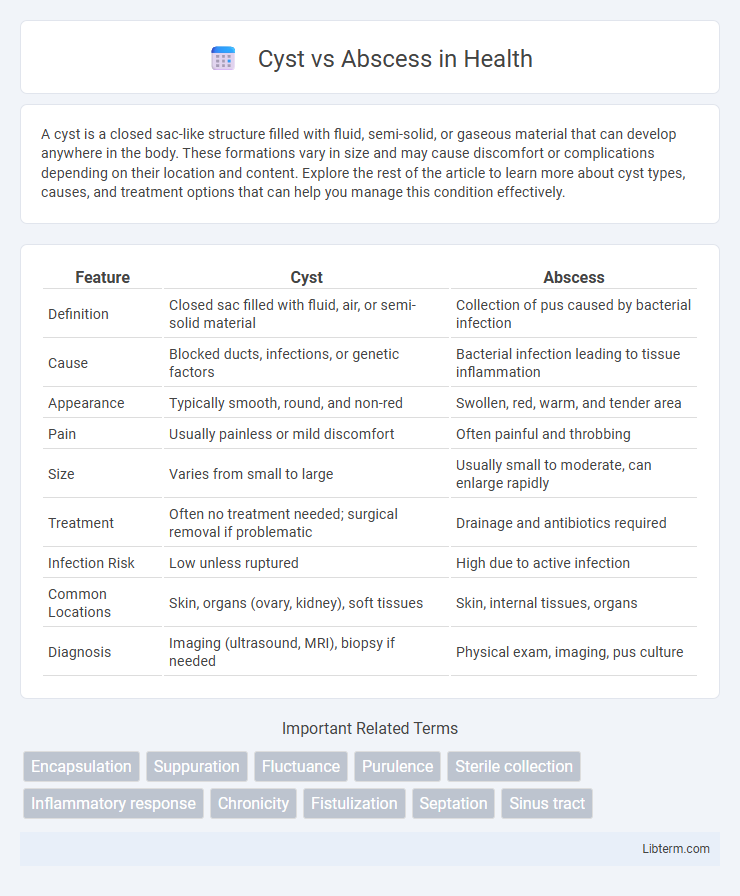A cyst is a closed sac-like structure filled with fluid, semi-solid, or gaseous material that can develop anywhere in the body. These formations vary in size and may cause discomfort or complications depending on their location and content. Explore the rest of the article to learn more about cyst types, causes, and treatment options that can help you manage this condition effectively.
Table of Comparison
| Feature | Cyst | Abscess |
|---|---|---|
| Definition | Closed sac filled with fluid, air, or semi-solid material | Collection of pus caused by bacterial infection |
| Cause | Blocked ducts, infections, or genetic factors | Bacterial infection leading to tissue inflammation |
| Appearance | Typically smooth, round, and non-red | Swollen, red, warm, and tender area |
| Pain | Usually painless or mild discomfort | Often painful and throbbing |
| Size | Varies from small to large | Usually small to moderate, can enlarge rapidly |
| Treatment | Often no treatment needed; surgical removal if problematic | Drainage and antibiotics required |
| Infection Risk | Low unless ruptured | High due to active infection |
| Common Locations | Skin, organs (ovary, kidney), soft tissues | Skin, internal tissues, organs |
| Diagnosis | Imaging (ultrasound, MRI), biopsy if needed | Physical exam, imaging, pus culture |
Introduction to Cysts and Abscesses
Cysts are closed sac-like structures filled with fluid, semi-solid, or gaseous material, commonly found in tissues throughout the body. Abscesses are localized collections of pus caused by bacterial infection, leading to tissue inflammation and swelling. Both cysts and abscesses can present with swelling, but abscesses typically involve pain, redness, and heat due to infection, whereas cysts are usually painless unless ruptured or infected.
What is a Cyst?
A cyst is a closed sac-like structure filled with fluid, semi-solid, or gaseous material, often developing within tissues or organs. It can vary in size and may cause swelling or discomfort depending on its location, commonly found in areas like the skin, ovaries, or kidneys. Unlike an abscess, a cyst is typically non-infectious and forms due to blockages of ducts, congenital defects, or other underlying conditions.
What is an Abscess?
An abscess is a localized collection of pus caused by a bacterial infection, leading to inflammation and tissue destruction. It typically presents as a painful, swollen lump filled with pus, often requiring drainage and antibiotics for treatment. Unlike a cyst, which is usually a non-infectious fluid-filled sac, an abscess is an active infection that can cause fever and systemic symptoms if left untreated.
Key Differences Between Cyst and Abscess
A cyst is a closed sac filled with fluid, semi-solid, or gaseous material, often non-infectious and slow-growing, while an abscess is a localized collection of pus caused by a bacterial infection, resulting in inflammation and swelling. Cysts are typically painless unless they rupture or become infected, whereas abscesses usually present with pain, redness, and warmth due to the inflammatory response. Diagnosis and treatment differ significantly; cysts may require monitoring or surgical removal, whereas abscesses often need prompt drainage combined with antibiotics to prevent the spread of infection.
Causes of Cysts
Cysts commonly form due to blockages of sebaceous glands, infections, genetic conditions, or chronic inflammation. They result from the accumulation of fluid, pus, or other material within a closed sac under the skin. Unlike abscesses, cysts are typically non-infectious and develop slowly over time.
Causes of Abscesses
Abscesses are caused primarily by bacterial infections, where invading pathogens trigger the body's immune response, leading to pus accumulation. Common bacteria involved include Staphylococcus aureus and Streptococcus species, which enter through skin breaches, trauma, or blocked glands. Factors such as poor hygiene, compromised immunity, and underlying conditions like diabetes increase the risk of abscess formation.
Symptoms: Cyst vs Abscess
A cyst typically presents as a painless, slow-growing lump beneath the skin or within tissues, often without redness or warmth, whereas an abscess is characterized by a painful, swollen, and red area that may produce pus due to infection. Symptoms of an abscess include localized tenderness, warmth, and sometimes fever, indicating inflammation and bacterial invasion. In contrast, cyst symptoms are generally mild or absent unless the cyst becomes infected or ruptures, causing increased discomfort and swelling.
Diagnosis: How to Identify Cyst and Abscess
Diagnosis of a cyst involves imaging techniques such as ultrasound, MRI, or CT scans, revealing a well-defined, fluid-filled sac that is typically non-tender. Identifying an abscess relies on clinical examination showing localized swelling, redness, warmth, and pain, often supported by ultrasound or CT imaging to detect pus accumulation. Laboratory tests like elevated white blood cell count and culture of aspirated fluid further confirm abscess infection.
Treatment Options for Cysts
Treatment options for cysts primarily include monitoring for changes, aspiration, and surgical removal depending on size, location, and symptoms. Simple cysts that are asymptomatic often require no intervention, while symptomatic or infected cysts may be treated with needle aspiration to relieve pressure. Surgical excision is recommended for recurring or complicated cysts to prevent infection and ensure complete removal.
Treatment Options for Abscesses
Treatment options for abscesses primarily involve incision and drainage to remove purulent material and alleviate pressure. Antibiotic therapy is often prescribed to target the underlying bacterial infection, especially in cases of systemic involvement or immunocompromised patients. Pain management and proper wound care are essential components to promote healing and prevent recurrence.
Cyst Infographic

 libterm.com
libterm.com